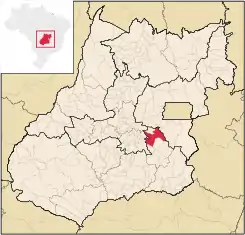Silvânia
Silvânia is a municipality in southcentral Goiás state, Brazil.
 Bandeira Silvânia Goiás Brasil | |
|---|---|
| State | Goiás |
| Coordinates: | 16°40′04″S 48°35′13″W |
| Area: | 2,864.7 km2 |
| Population: | 20,816 (IBGE 2020)[1] |
| Elevation: | 917 m above sea level |
| Postcode (CEP): | 76160-000 |
| IBGE statistical microregion: | Pires do Rio Microregion |
| Became a city: | 1847 |
| Distance to Goiânia: | 77 km. |
| Website: | none |

Location and highway connections
Silvânia is located 77 kilometers from the state capital of Goiânia, 180 km. from the national capital of Brasília, and 65 from the second most important city of the state, Anápolis. The highways that link it with other cities are: GO-330, GO-010, GO-139 and GO-437.
Connections starting in Goiânia are made by BR-457 / GO-010 / Bonfinópolis / Leopoldo de Bulhões / GO-437 / GO-139. See Sepin for all the distances.
It borders the municipalities of Gameleira de Goiás, Abadiânia and Alexânia to the north; Vianópolis, São Miguel do Passa Quatro and Bela Vista de Goiás to the south; Luziânia and Orizona to the east; Caldazinha and Leopoldo de Bulhões to the west.
The climate is tropical humid, with an average annual temperature of 23 °C. The annual rainfall is 1,750 millimeters. The vegetation is cerrado or savanna.
Political information
- Mayor: João Corrêa Caixeta (January 2005-January 2009))
- City council: 09
- Eligible voters: 13,258 (December/2007)
Demographics
- Population density: 8.11 inhabitants/km2 (2007)
- Population in 1980: 19,809
- Population in 2007: 18,370
- Urban population: 11,968 (2007)
- Rural population: 6,502 (2007)
- Population growth rate: -0.19% 1996/2007
The economy
The main economic activities are dairy cattle and soybean growing. Silvânia has large areas planted in soybeans and corn. Brick making is also very important for the local economy. Production is shipped to Goiânia and Brasília.
- Industrial units: 34 (2007)
- Commercial units: 159 (2007)
- Dairy: Granja Leiteira Sol Dourado Ltda. - Coop. Agrop. dos Prod. Rurais de Silvânia (22/05/2006)
- Financial institutions: Banco do Brasil S.A. - CEF - Banco Itaú S.A. (08/2007)
- Cattle herd: 104,300 head (26,500 milk cows)
- Main crops in 2006: cotton, rice, sweet potatoes, coffee, sugarcane, barley, beans (1,690 hectares), guava, oranges, manioc, corn (3,180 hectares), soybeans (50,000 hectares), and tomatoes.
Agricultural data 2006
- Number of farms: 1,914
- Total area: 176,952 ha.
- Area of permanent crops: 1,471 ha.
- Area of perennial crops: 58,498 ha.
- Area of natural pasture: 79,473 ha.
- Area of woodland and forests: 34,114 ha.
- Persons dependent on farming: 1,632
- Farms with tractors: 332
- Number of tractors: 690
- Cattle herd: 104,300 head IBGE
Education (2006)
- Schools: 16
- Total Students: 5,027
- Middle school enrollment: 731
- Higher education: Unidade Universitária da UEG
- Adult literacy rate: 88.0% (2000) (national average was 86.4%)
Silvânia is home to two of the most important schools in the last century in Goiás, Instituto Auxiliadora and Ginásio Anchieta.
Health (2007)
- Hospitals: 1
- Hospital beds: 44
- Ambulatory clinics: 10
- Infant mortality rate: 15.08 (2000) (national average was 33.0)
- MHDI: 0.777
- State ranking: 36 (out of 242 municipalities)
- National ranking: 1,223 (out of 5,507 municipalities) For the complete list see:
Tourism and History
Silvânia has cultural attractions that are valuable for local and regional culture. Monuments from the eighteenth century, century-old houses, possible archeological and remains of the bandeirante and Black colonization are some of the attractions.
Presently Silvânia has about 14 establishments related to tourism: six hotels, five restaurants and three camping grounds.
Unlike many cities in the state of Goiás, Silvânia has a long history, beginning in 1774 when miners coming from Santa Luzia, present-day Luziânia, found gold in the region. Soon a small settlement, called Bonfim, was established. In 1943 Bonfim was substituted by Silvânia in tribute to a local figure, Vicente Miguel da Silva.